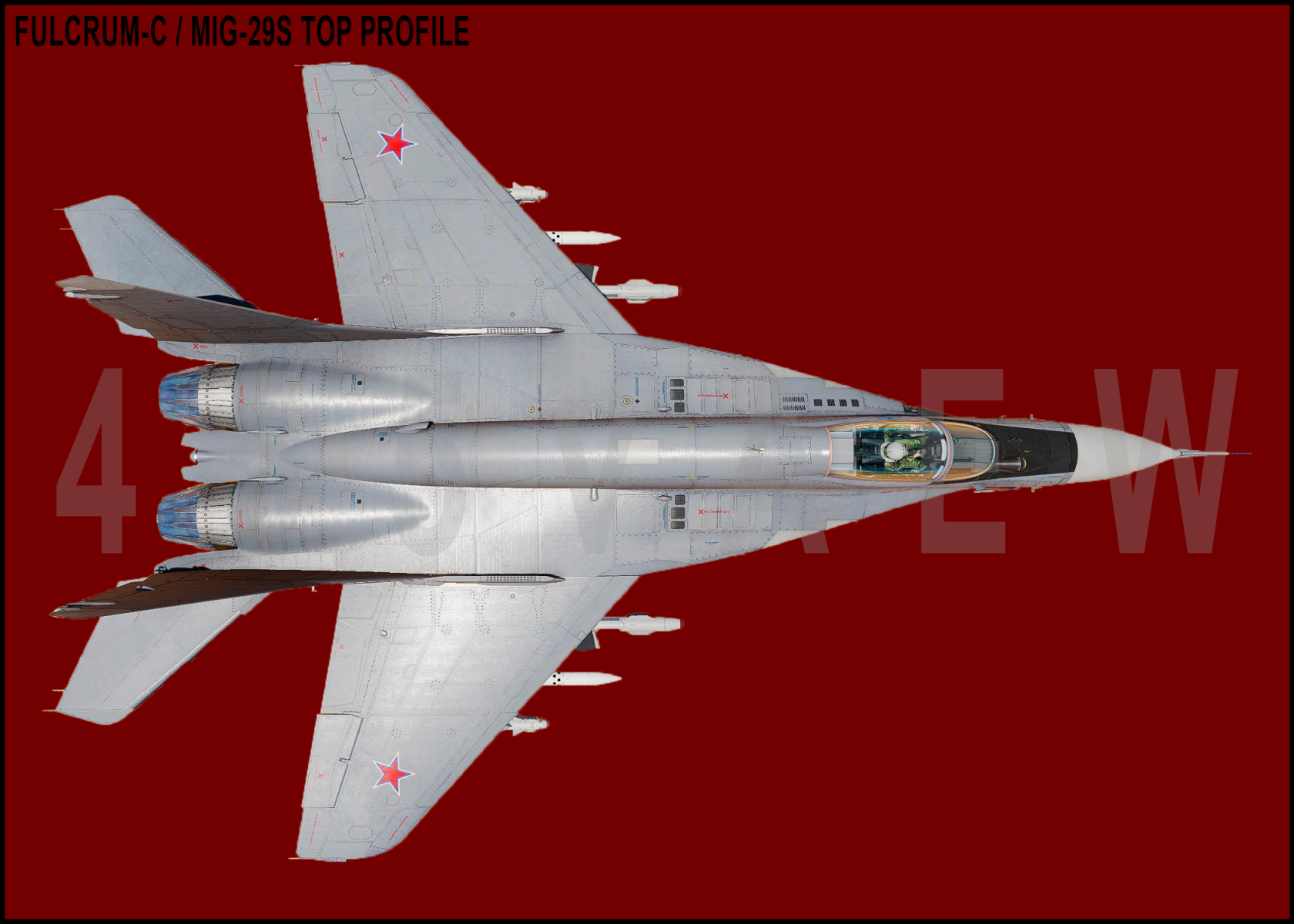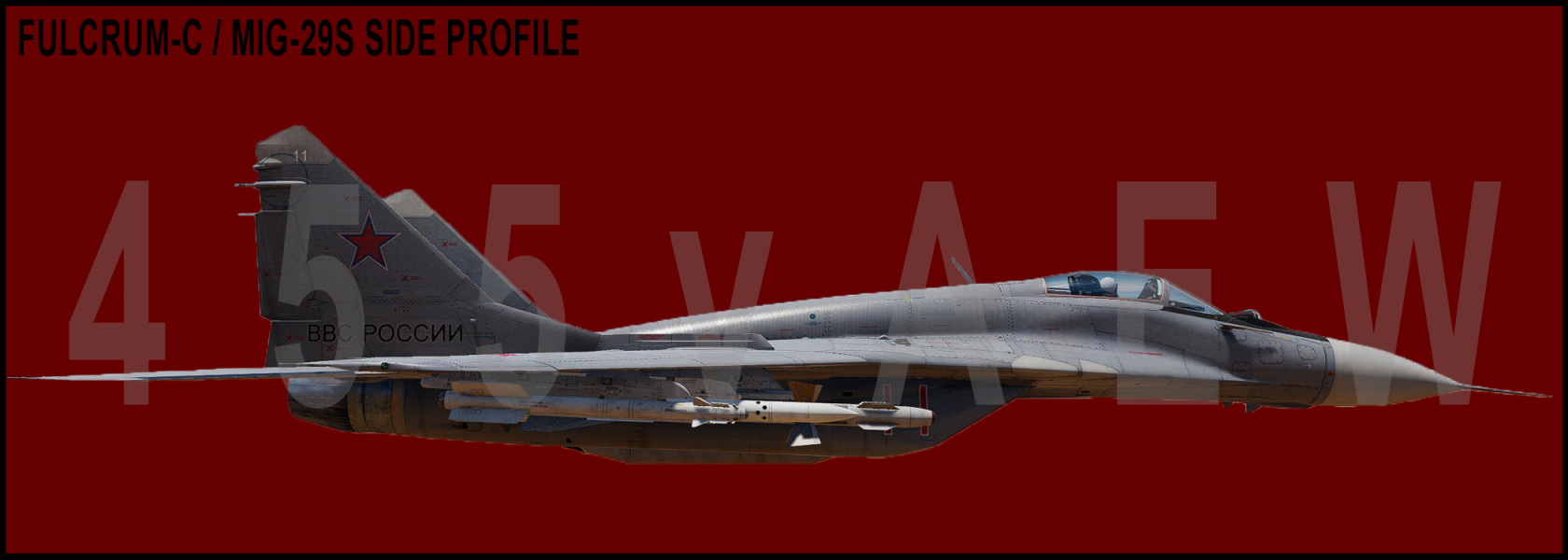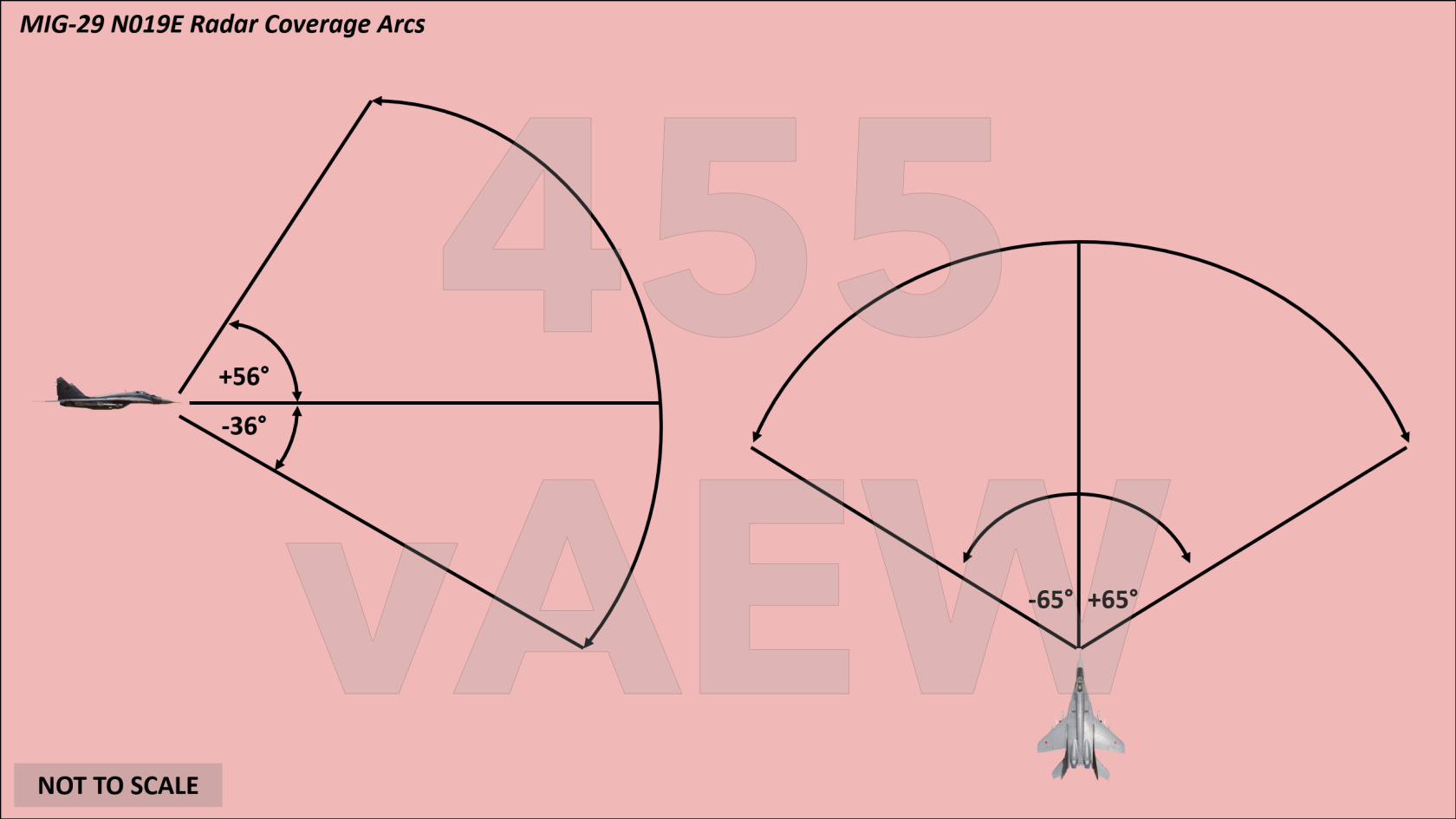FULCRUM / MIG-29
FULCRUM / MIG-29
This FULCRUM is equipped with the N-019E SLOTBACK look-down shoot-down radar. The airplane is also equipped with the SPO-15 RWR system, capable of detecting the F-16 out to 23 – 25nm. away, and a passive IRST that is capable of detecting MIL power targets out to about 12nm. in the rear quarter. The onboard self-defensive suite consists of CMDS only.
The MiG-29's wings are swept-back and tapered with square tips. Leading Edge Root Extensions (LERXs) are wide and
curved down to the front. LERX begins on the nose below the mid-mount point, and the wings’ trailing edges end at a high-mounted point. Twin jet engines are mounted low and to the sides of the fuselage. Diagonal-shaped air intakes give a
box-like appearance. There are large exhausts. The fuselage is made of a long, thin, slender body with long, pointed drooping nose. There is a high-mounted bubble canopy. The tail fins have sharply tapered leading edges, canted outward with angular, cutoff tips. Flats are high-mounted on the fuselage, movable, sweptback, and tapered with a negative slant.
Variants
- MiG-29 FULCRUM-A Initial production version; entered service in 1983.
- MiG-29S-13 FULCRUM-C MiG-29 variant similar to the Fulcrum-A but with an enlarged fuselage spine containing additional fuel and a Gardeniya active jammer.
Airframe
- Length - 57'
- Wingspan – 37' 3”
- Height – 15' 6”
- Wing Area – 409 ft2
- Empty Weight – 24255 lb
- Combat Weight – 43000 lb
- Max Takeoff Weight – 46300 lbs
- Wing Loading – 90.5 lb/ft2
- Power Plant
- 2× Klimov RD-33K afterburning turbofans
- 18300 lb wet thrust
- 11100 lb dry thrust
Aerodynamic Handling
The MiG-29 possesses excellent slow speed handling qualities and is capable of better turn and high AOA performance than the F-
16 below 250 knots. Acceleration at low speeds is quick due to the high thrust of the RD-33 engines, and the aircraft is more than a match for the F-16 in the slow speed regime.
Turn / Dogfight Capabilities
- Instantaneous Turn – 21 deg/sec
- Sustained Turn – 15 deg/sec
- Max AOA – 30 degs
- Max-G
- Above M0.85 - +7.5/-2.15
- Below M0.85 - +9.0/-2.25
- Vertical - High
- Horizontal - Very High
- Trust Rate Ratio: 1.11 Clean
Combat Radius
A MiG-29 Fulcrum-A carrying a centerline fuel tank will need 400kg of fuel for startup, taxi and takeoff, 500kg for a engagement (including one minute of afterburner) and will usually need to have 1,000kg reserve for the return to base. This will leave 2,500kg of fuel for operations: enough to travel 408nm at Mach .8 at 40,000ft with five minutes loiter time. Or to put it another way, at the optimal range profile (Mach 0.8, 13,000 m) assuming expenditures of fuel for startup, taxi, and climb to 13,000 ft at roughly 1180kg, the MiG is left with 2100kg for flight. Assuming that the top of descent is made roughly 100km out and at idle power, the maximum range of the MiG-29 (at Mach 0.8) is roughly 1450km. With the centerline tank that becomes 2090km
- Combat Radius - 400nm
- Ferry Radius - 1130nm
Avionics
Radar
This airplane is equipped with the N-019E SLOTBACK look-down shoot-down radar. This radar is more hardened against ECM and
less susceptible to notching, and the airplane is also equipped with an internal jammer and CMDS. Able to track 10 targets simultaneously. Range 60 NM.
The N019 radar weighs around 849lbs in total. It is a pulse-doppler radar operating in X band around 3cm wavelength. It uses
three basic operating regimes. High PRF radar mode for optimal detection of closing targets, medium PRF mode for optimal detection of receding targets, and an interleaved high/medium PRF mode for all aspect detection. It uses a guard channel for sidelobe suppression. SARH Illumination and main channels use different frequencies within the X band, and are multiplexed in time. Individual aircraft can be preset on the ground to different frequencies to avoid mutual interference during group operations.
Scanning cycle times are 2.5-5 seconds depending on mode. Beam width is 3.5º, which determines the minimum separation of two targets in azimuth. The radar beam is stabilized up to 120º in roll and +40º/-30º in pitch.
Radar Modes
V – Encounter. Encounter mode is the main search mode used in interception, as it gives the longest detection ranges and the
least false returns. It uses a High PRF mode which can detect closing targets only in the velocity range of 230 - 2500km/h at altitudes from 30m to 23,000m. The display is calibrated to a maximum range of 150km. Target can be up to 10,000m above or 6,000m below the host aircraft's own altitude. A typical 3m2 RCS fighter target can be detected at 50-70 km and tracked at 40-60 km. If the target is flying below 3,000m reduces the detection range to 40-70 km and tracking range to 30-60km.
When the system is under direct GCI control via datalink, a 6-bar elevation raster scan is used. This scan covers a sector
of 40° in azimuth at ranges up to 30km, 30° at ranges of 30-55 km, and 20° above 55km within the scan limits given above. The distance to target and other useful information is supplied by GCI command, and the direction of the scan is automatically cued by CGI command towards the desired target.
When the system is not under direct GCI control via datalink, a 4-bar raster scan mode is used to acquire a target manually. This mode scans a constant 50° in azimuth, with the pilot controlling the direction of the scan. It is expected that the rough direction to the target will be given by ground control via voice commands.
There is no scan pattern for full azimuth range scanning. The 130º scan area is divided into 3 sectors. Left sector is
-65º to -15º, center sector covers -25º to +25º, right sector from +15º to +65º, giving overlapping coverage of the full 130º scan limits. Individual targets can be resolved providing they are separated in azimuth and 5-6km in range. Range measuring error of a single target can be as high as 8km, which should be recalled when comparing measured target range with that supplied by GCI controller.
Minimum measurable range in this mode is 5km.
Lockon and transition to tracking mode takes 2 to 7 seconds in Encounter mode.
Note that in Encounter mode, a target that changes direction to a tail-on engagement may be be lost even when in tracking mode, if it is no longer closing.
Mode D – Pursuit
A medium PRF mode usable for both headon and tailchase engagements. In practice it is used only when necessary, as it
is prone to displaying false targets from ground clutter especially at low altitudes. Marsh land, marshy forests and flood plains give greatest clutter problems. When multiple false returns are present, the pilot should compare visible targets with the calculated target range supplied by datalink from GCI controller to determine the correct target.
Display is calibrated to a maximum range of 50km.
Detects targets from 30 m to 23,000 m altitude receding at speeds of 210 - 2200 km/h.
Target can be up to 10,000m above or 6,000m below.
Range against a typical 3m2 RCS fighter target is 25-35km search and 20-35km tracking when host aircraft is flying above 3000m. When flying from 1000m to 3000m altitude, range is reduced to 20-35km search and 18-35km track. When flying at 500- 1000m achievable range is just 15-30km search and 13-25km tracking.
When target range is below 20km, scan coverage is 40º in azimuth, 16.5º in elevation.
If target range is above 20km, scan coverage is 30º in azimuth, 13.5º in elevation.
Individual targets can be resolved providing they are separated 3-4km in range in Pursuit mode.
Errors in range measurement can be as high as 8km, but there is no minimum range.
Lockon and transition to tracking mode takes 1-4 seconds in Pursuit mode.
When "Cooperation" mode is selected, the radar is automatically switched to an equivalent mode to pursuit, scanning with the IRST.
AVT – Automatic
Automatic mode uses a mixture of High and Medium PRF to give optimal all aspect detection. Each line of the scan is alternated between high and medium PRF, unless range is under 10km when only medium PRF is used.
It generates a display calibrated to a maximum range of 100km. Targets can be theoretically detected at similar ranges to Encounter and Pursuit modes according to targets direction of movement.
In Automatic mode tracking of a target should continue regardless of target direction provided rate of closure/opening is sufficiently high.
It is considered by pilots to be quite problematic, overloading the data computer and generating numerous false returns.
It is primarily intended for use when lacking information from the ground station concerning the target's direction.
Track-while-flyby submode is not available in AVT mode. AVT mode provides the same functionality automatically.
SNP Mode
Track-While-Flyby mode. Track-While-Flyby submode can be set in Encounter or Pursuit modes only.
Track-while-flyby mode allows the simultaneous tracking of up to 10 targets, measuring their angular position, range
and rate of closure. The target with the highest rate of closure/range ratio is designated the most dangerous, and automatically marked on the display. The pilot can override the automatic selection if he decides on another target. After switching to track-while-flyby mode it is not clear if the radar continues volume scanning, and it may be that only the (up to 10) tracked targets are followed. Track-while-flyby mode will automatically follow the target marked most dangerous (automatically or by pilot override) in elevation, within the elevation limits of the radar, without pilot intervention.
The TSVM computer calculates missile launch parameters for the most dangerous target. As the range to target
approaches the calculated maximum missile launch range, the radar will stop scanning for targets and transition to an 8º by 40º box pattern scan in the direction of the designated target. If the target is located, the radar will transition to single target tracking mode, and all other contacts are discarded. If no target is found within 3 cycles, the radar returns to scanning mode.
Track-while-flyby mode is intended to allow missile launch at maximum range with minimal warning to the target, by switching to true single target tracking mode as late as possible.
Close Combat mode overrides all other modes. It uses a + 37º/ -13º fixed directly ahead vertical scan that is 6º wide (2
scan lines) with a 2.5 sec scan cycle and provides semiautomatic target acquisition. The closest target present in the scan area will be locked when pressing the lockon button without having to designate it.
Close Combat mode can lockon from 450 m to 10km in range, and track a locked on target down to 250m.
It is not slewable, but fixed straight ahead only. Targets can be tracked in a closure rate range from +300 meters/second to -500 meters/second including co-speed targets.
Lock-on and transition to tracking mode takes 1-2 seconds in Close Combat mode.
The SLOTBACK's search range is 54 NM, tracking range 38 NM, tracking limits 60 deg. Up, 38 degrees down, 67 degrees each side, collimated with a very accurate laser range finder.
One way of distinguishing the MiG-29 variants that you may encounter is to use STT lock on the contact. If the target breaks
your lock with jamming, you are facing the Russian MiG-29C.
ECCM Features - Burnthrough Ranges
- MIG-29A or -29B – 12-15nm
- MIG-29C - 15-18nm
Look-down/Shoot-down Capabilities
IRST Capabilities
A passive IRST is installed that is capable of detecting MIL power targets out to about 12nm. in the rear quarter.
Defensive RWR - The airplane is also equipped with the SPO-15 RWR system, capable of detecting the F-16 out to 23 – 25nm. away. The RWR signature will not show a difference as the N-019ME Topaz radar is an N019E SLOTBACK radar receiver married to an upgraded digital processor.
Expected Contact Ranges
- APY-1/2: 270-210nm
- Target RCS 5m2
| Ownship Aircraft |
Nominal Detection Range |
Lookdown Detection Range |
MiG-29 RWR Detection Range |
| F-15 | 58.5nm | 36.3nm | 33.8nm |
| F-16 | 38.4nm | 23.0nm | 24.2nm |
Air to Air Armament
| Aircraft | IR WVR Missiles |
WVR Semi-Active Radar Homing |
IR BVR Missiles |
Semi-Active Radar (BVR) |
Active Radar (BVR) |
| MIG-29A | AA-8, AA-11 | X | AA-10 | AA-10 | X |
| MIG-29S | AA-8, AA-11 | X | AA-10 | AA-10 | AA-12 |
Radar Missile
- MIG-29A
- up to 2 x R-27 (AA-10A ALAMO-A) / (AA-10B ALAMO-B) / (AA-10C ALAMO-C) / (AA-10D ALAMO-D)
- MIG-29S
- up to 6 x R-77 (AA-12)
- up to 2 x R-27 (AA-10A ALAMO-A) / (AA-10B ALAMO-B) / (AA-10C ALAMO-C) / (AA-10D ALAMO-D)
Heat Missile
- up to 6 x R-60 (AA-8 APHID) / R-60M (AA-8 APHID-B)
- up to 6 x R-73E (AA-11 ARCHER)
Gun System
- 1 x GSh-301 in left LERX, with 150 rds
Offensive Strike Capabilities
Able to carry FAB-250 bombs, KMGU-2 submunitions dispensers, 3B-500 napalm tanks, and 80 mm, 130 mm and 240 mm rockets in ground attack role.
Defensive Systems
The onboard self-defensive suite consists of CMDS only.
- Chaff – 30 x 26mm Chaff cartridges
- Flare – 30 x 26mm Flare cartridges
Countertactics
In the WVR arena, the MiG-29 is a very capable opponent with the HMS/AA-11 combination. Even in less than capable hands, this combination can bring about rapid grief to most Western fighters. IRCM tactics will obviously be in order here to deny the front quarter AA-11 shot, but you should be aware that a shot can be taken up to 45° off boresight. Whenever possible, you should avoid engaging the MiG-29 in a knife fight, as this is where the MiG-29 really shines. If you do, remember to keep your speed high and above 350 knots so as to maximize the F-16’s advantage, and avoid getting slow. According to some early
USAF pilots who flew “against” the German Luftwaffe’s JG73 MiG-29 squadron in some mock dogfights at the Decimomanuu ACMI range:
“We encountered some positions, particularly in an across-the circle shot or a high-low shot and in a slow-speed fight, where a Fulcrum pilot can lookup up forty-five degrees and take a shot while his nose is still off…Below 200 knots, the MiG-29 has incredible nose-pointing capability down to 100 knots. At higher speeds, we can power above them to go to the vertical, and our turn rate is significantly better. By being patient and keeping airspeed around 325 knots, an F-16 can bring the MiG-29 to its nose. But, the pilot must still be careful of the across-the-circle shot with that helmet mounted sight.” (Reprinted from “Schlemming with the Fulcrums)”
You should exploit your ECM equipment to maximize your advantage in BVR, and engage the MiG-29 from BVR. The DPRK MiG-29 lacks ARH missile capability, so this is where the F-16 with the AIM-120 has the edge. The MiG-29/AA-10A combination does not give it much BVR range (this is only slightly further than the AIM-7), and ECM usage should prevent a shot from up to 12 – 15nm away. Having an early AIM-120 shot at it will put the MiG-29 driver on the defensive, allowing you to deal with it at arms length and avoid a close-in fight.
However, the Russian MiG-29 is of the FULCRUM-C variant (9- 13 designation). Always bear in mind the MiG’s advantage in WVR with its HMS/AA-11 combination, and excellent slow-speed handling. Proper throttle management and positioning will decrease the shot opportunity and improve your chances of survival.
Alamo Shot / Radar – Beam with Chaff
Archer Shot / Radar - Throttle to idle w/flares and beam, avoid 120 deg arc in front of Fulcrum
Turning Fight – Stay at Corner Velocity – 350-450 KIAS



